I shared this photo of my grandmother Eveline Coates’ high school graduating class in Mystic, Iowa a few weeks ago. Along with the photo and her diploma, a couple of other mementos were saved. One is the program for the Junior-Senior Banquet in honor of the graduating Seniors. It was interesting to see how World War I seemed to be the overarching theme of the festivities. I decided to take a deeper look at what her life may have been like during the 1917-1918 school year. There was a lot going on, a war and the beginning of an influenza pandemic to name the two biggies. See Eveline’s Senior Year, Part 1
Six weeks after the United States formally entered World War I, the Selective Service Act went into effect on May 18, 1917. The act required all men in the U.S. between the ages of 21 and 30 to register for military service. Eveline’s two oldest brothers, Carl and John, were required to register and did so on the national registration day, June 5, 1917. (Click to enlarge photos.)
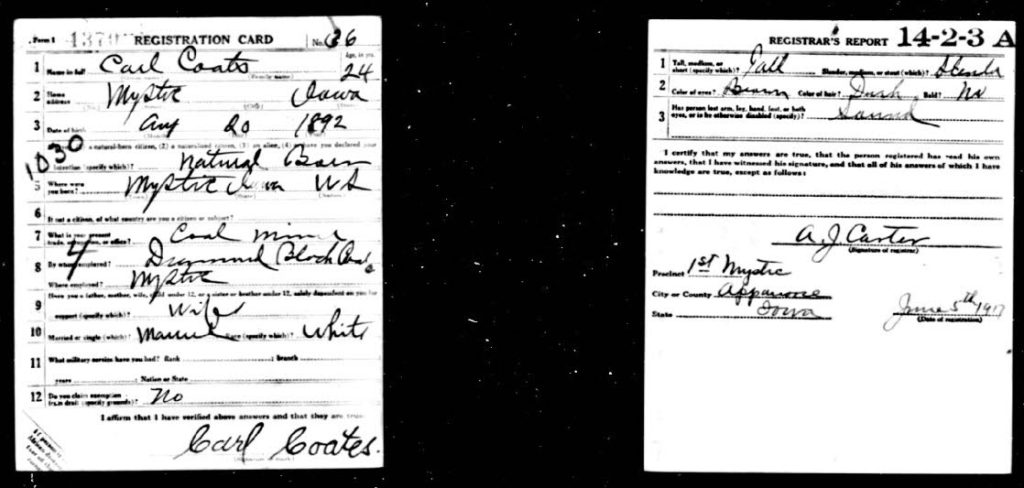
Carl was twenty-four years of age, married, and living in Mystic at the time of his registration. He and his wife, Nellie Metcalf, had married in September of 1916 and were expecting their first child.

Eveline’s brother John was twenty-two, single, and presumably living in his parent’s home. Although his registration card has an incomplete second page, we can assume he also registered on June 5th, as required. Anyone who did not register was subject to arrest.
A headline on the front page of the June 8th edition of a local newspaper published in Centerville, the county seat, read: Hope of Allied Victory in 1917 Gone – Prepare for Three Years. Not a headline anyone would want to read.
Carl, married and with a child on the way, would be exempt from the draft.
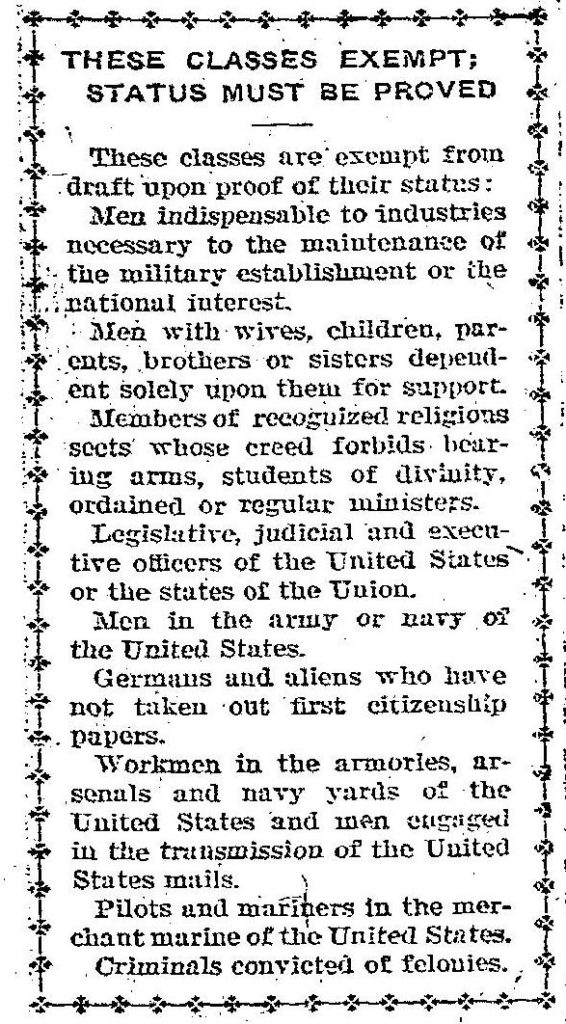
Eveline became an aunt on June 29, 1917, when Carl’s wife, Nellie, gave birth to Pauline June Coates. It must have been an exciting event for Eveline.

I haven’t found a photo of Pauline as an infant, but here is a photo of Nellie and son, Keith, born in 1921.
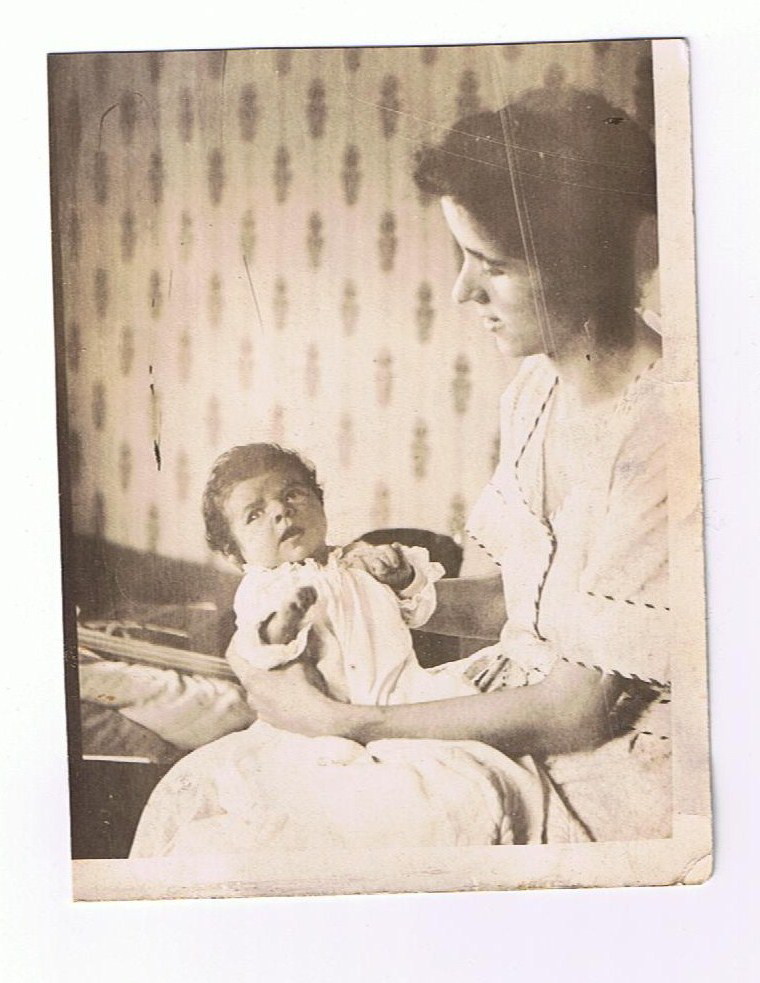
On July 21st, the paper printed a list of men whose names had been drawn in the first draft. A more complete list was published on the 23rd. And on the 30th, the paper published a list of the 384 men in the county who were required to report for examination.

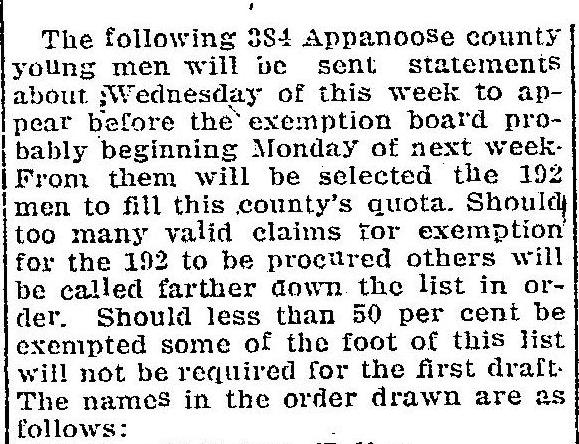
John’s number wasn’t selected in the first draft. Perhaps John and the rest of the family breathed a sigh of relief, at least for the moment.
In addition to men enlisting, names being drawn for the draft, and general concern about the war, the area was experiencing a heat wave and a very little rain. There was concern about the survival of the corn crop.
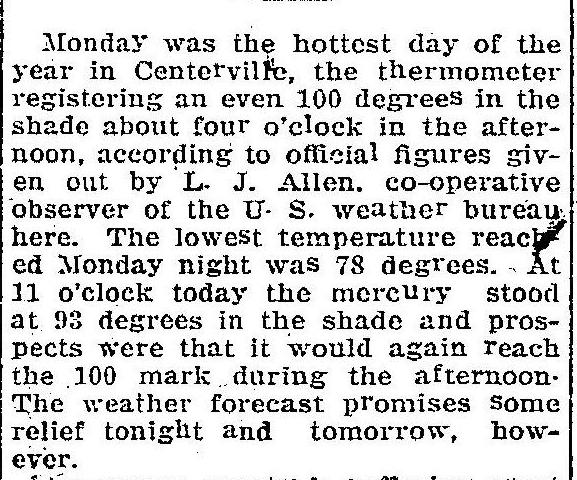
On the hottest day of the year The Great Patterson Shows opened in Centerville for a six day engagement.
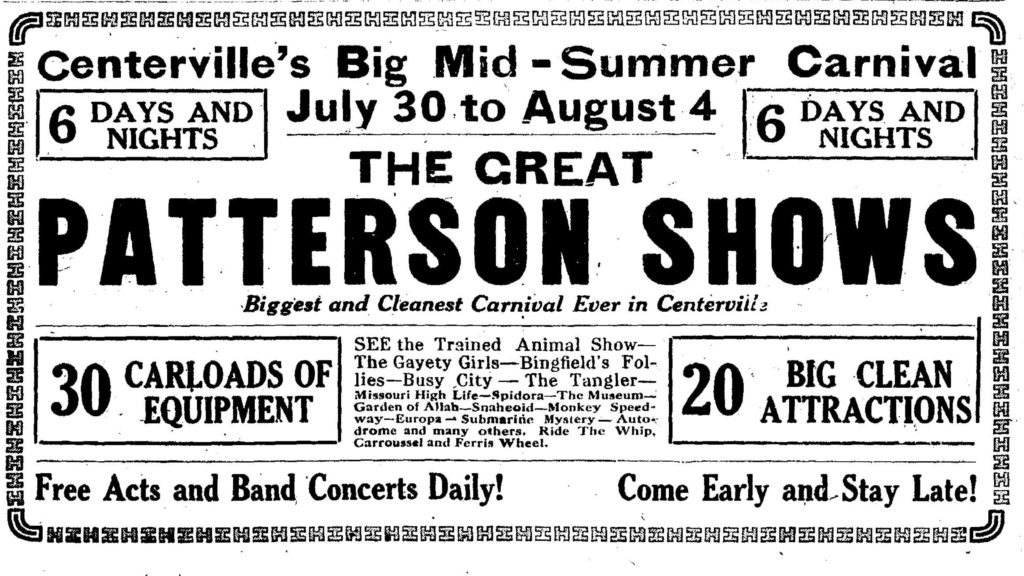
John and some of his friends must have been intrigued by the prospect of the carnival shows – or maybe were simply in need of entertainment and distraction from news of the war and what their futures might hold. Maybe there would even be some cold drinks and carnival fare to make things bearable. Did they hop on the Interurban, or did someone have a car?

The Circus History Society website provides this information about the Patterson Shows:
The biggest circus deal of the year was consummated by James Patterson, sole owner of the Great Patterson Shows, when he purchased from Gollmar Brothers their entire circus property, known as Gollmar Brothers Circus. Mr. Patterson took complete charge at Fredericktown, Mo., and shipped the show into his winter quarters at Paola,Kan. For the past seventeen years Mr. Patterson has been the successful owner of a big carnival company. Recently he incorporated under the title of The James Patterson Trained Wild Animal Show. Stock was issued and about half of it was immediately taken by friends of The Great Patterson Shows, with no particular effort on the part of Mr. Patterson to dispose of it. The property and title of the James Patterson Trained Wild Animal Circus will be combined with the Gollmar Brothers’ property and title, and it is Mr. Patterson’s intention to make it the best twenty-five car circus in America.
The deal covers the entire circus as a going concern. There are seventy-eight head of fine baggage horses, about thirty-five head of ring stock, seventeen dens of animals, including the Gollmar hippopotamus, and twenty-five cars, together with all the wagons and paraphernalia of every description. The officers of the James Patterson Trained Wild Animal Circus are James Patterson, president and general manager; A. T. Brainerd, vice-president; Raymond E. Elder, treasurer, and A. K. Kline, secretary. The Great Patterson Shows Carnival Company will not be affected in any way by this addition to the Patterson interests. . . . Mr. Patterson will devote his entire time to the management of the circus. Harry S. Noyes will look after the railroad contracting of both shows, and Raymond E. Elder will be the general agent. The circus property will take the roade as a twenty-five car show.
Billboard, November 11, 1916, pp. 26, 27.
Perhaps the arrival looked something like this.

A few images of the Patterson Shows.


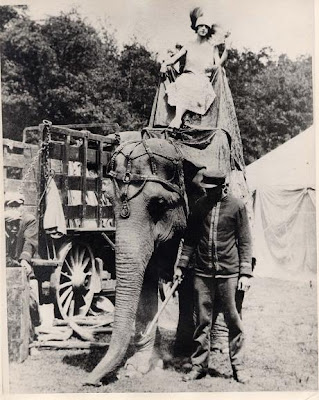
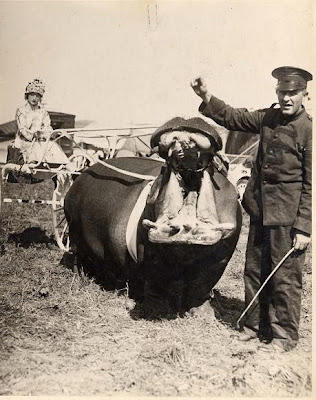
One of the acts mentioned in the newspaper article is the Don Carlos Dog and Monkey Hotel.
Around the turn of the 20th century, a show promoter from Flint, Mich., carried a traveling show from state fair to state fair. It featured the Don Carlos Dog and Monkey Hotel. Newspapers from Kentucky to Oklahoma to Texas raved about the spectacle. “A miniature hotel on the stage is operated entirely by monkeys and dogs,” the Eastern Utah Advocate reported on Aug. 28, 1913, “and romances and disagreements with police interference and the ultimate removal to jail and the trial of all wonderfully enacted and the audience is sent into spasms of laughter by the antics of the educated animals.” The hotel “is the cutest and funniest show travelling,” noted the Indian Journal of Aufala Oklahoma. “The best poodle dogs and monkeys … run a hotel. It is an act for women and children as well as men.” In Texas, the El Paso Herald reported, the dog and monkey show was paired with an educated horse performance. The horse, Red Riding Hood, “spells, adds, waits table, tells ages, gets mail and assumes wonderful poses on the instant of the command and without a perceptible cue.”
https://www.npr.org/sections/npr-history-dept/2015/03/05/386957834/amazing-animal-performers-of-the-past

The newspaper followed up with another article once the carnival arrived.
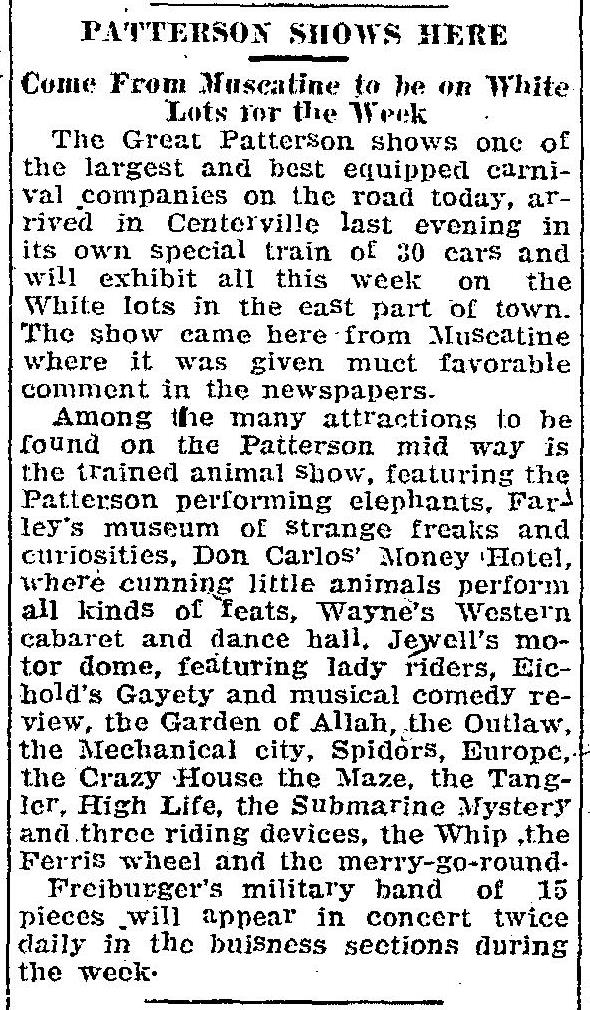
I was not able to find a photo or much in the way of information about Earle Freiburger, who I infer was the bandleader in the article above. This 15 member military band may or may not be under the direction of Mr. Freiburger.

When I started this post, I knew I would not match the prompt photo this week. But as I read my way through three months of old newspapers, there was John Coates at a carnival right in the midst of registering for the draft and waiting for his number to come up. It seemed to fit.
I hope John had fun. Did he go home with lots of stories to tell Eveline? Was she jealous or just pleased to hear all about it?
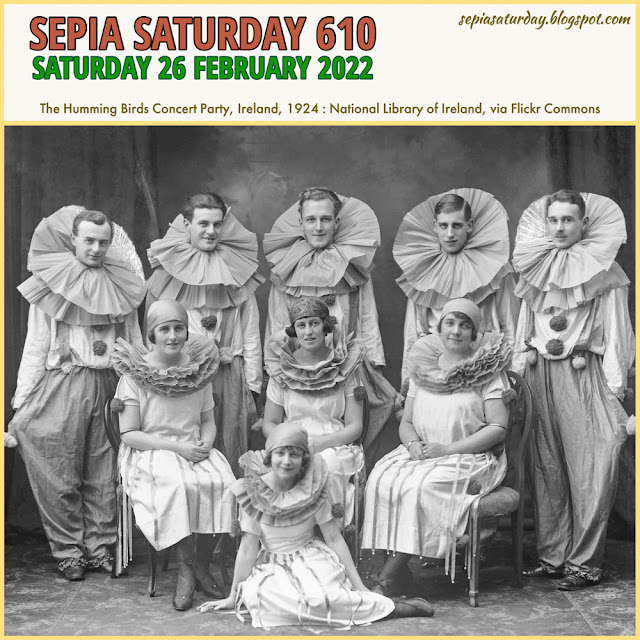
Get in your clown car or hop on the circus train and see what spectacles await at Sepia Saturday.
Sepia Saturday provides bloggers with an opportunity to share their history through the medium of photographs. Historical photographs of any age or kind become the launchpad for explorations of family history, local history and social history in fact or fiction, poetry or prose, words or further images. If you want to play along, sign up to the link, try to visit as many of the other participants as possible, and have fun.




No use just sitting around waiting for his number to come up. Might as well have some fun – live it up with something interesting and different while you wait! Smart boy.
Absolutely!
What a great story! It’s amazing how many people’s names appeared in newspapers back in the day. I’ve come across many of those local lists of men who got drafted in 1917/18. Unlike the British and French in 1914, by that time Americans knew how deadly the war could be. Families could not help but be worried. I wonder if there was a subtle propaganda in printing the names so as to put peer pressure on those men who weren’t on the list.
As you know, I’m fascinated by the history of these traveling circus and carnival shows. The transportation logistics alone for a small show like the Patterson must have rivaled, or even exceeded, anything the military could do in moving soldiers and equipment. Imagine trying to travel with a hippopotamus, much less a few elephants! A tank or a howitzer would be easier.
I was thinking about you as I added the photos of the circus acts and the band. How do you even get a hippo on a train? I left out a part of the Patterson Show story – a couple of years earlier, the lion tamer lost his life as the audience looked on.